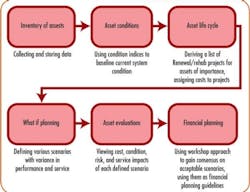The Pipe & the Precipice
• A break in a clay pipe over a 100-foot cliff in Oregon north of Portland along the Columbia River offers challenge for repair and installation of Perma-Liner system for Zwald Industrial Services
On May 19, 2007, the Zwald Industrial Services crew met with Justin S.E. Rush, an engineer with the city of St. Helens, OR, onsite at a local veneer mill to assess what was to be one of our most complicated jobs ever. We stood at the top of a 100' cliff and stared down a 211'-long and 6"-diameter pipeline under a bed of blackberry briars on unstable ground. The cliffside was made of solid rock with a top layer of loose soil, boulders the size of bowling balls or smaller, and garbage debris. Due to ground shifting over the years, the old vitrified clay pipe cracked and a had hole about 5" in diameter. Soon a contaminated stream of sewage ran down the cliff, collecting in an unpaved part of the mill parking lot below.
Rush Job
The Oregon Department of Environmental Quality (DEQ) had scheduled an inspection at the mill 10 days out, since raw sewage in any unconfined, uncontrolled environment is a hazard to the public and animals that may come into contact with the waste. Circumstances such as these would require the mill to be shut down, costing production time and money until the area could be cleaned and sanitized, not to mention potential fines. The seriousness of the situation required immediate response. The day after submitting our proposal to the city, Rush contacted Zwald to inform us it had accepted our bid. We now had four working days with no time to waste to complete the job.
Safety First
The incline on the cliff face was steep enough that our safety advisor Greg McDonald, of Public Works Supply, recommended a “rope-grab system” as a lifeline for workers scaling the precipice, since sure footing wasn’t a guarantee no matter where you stepped. Boulders that appeared stable slid underfoot and visibility was poor through overgrown vegetation. You never knew whether your next step would be on solid ground or nothing at all. As such, certified installer Steve Neal, strapped into a safety harness, first cleared the path along the pipeline with a bladed weed-eater, adding another element of danger.
Sanitary Bypass
Now, lead technician/certified installer Eric Manning and I began carrying up the cliff 20' lengths of 6" diameter 3034 snap-fit PVC to reroute the sewer and prevent further leakage from the broken pipe. One section at a time was snapped together from the bottom up, following the contour and slope of the existing sewer line without need of a level. With the bypass completed, we plugged the old line with a bladder at the hub in the manhole and detached it at a joint. We moved the new line into place, hooked up our ferncos (rubber connectors) and deflated the bladder. After flow was reestablished in the bypass, we waited, watched and walked the entire line, checking for leaks. To keep it stable over the weekend, we drove 18” stakes into the ground and tied off the line with ropes to the stakes and to trees for stability. City officials were scheduled to make regular visits to the site over the weekend to verify the bypass line hadn’t been tampered with and was free from leaks, breaks, and separated joints. The entire area was coned off as a safety zone to prevent anyone unauthorized from entering. We then cleaned up the site and headed home for a three-day Memorial Day weekend.
Preparatory WorkThe sanitary bypass is fitted into place at a veneer mill in St. Helens, OR, that needed a quick pipeline repair and relining over a steep cliffside.
Back at the jobsite Tuesday with our Perma-Liner trailer, lining equipment and supplies, we prepped as much as possible to allow shooting the lateral liner on Wednesday. We did a video pre-inspection, laid out the Perma-Liner material and made our marks. Cal tube, pull tape, amount of resin to be used, oil, plywood, etc., was measured out, checked and double checked for accuracy. We connected our inverter, 15 feet of delivery tube and inversion head together, and practiced swinging the contraption over the cliff edge to the open end of the exposed line. I would have to travel to the bottom of the cliff and quickly scale the slope during actual installation to position the inversion head correctly as the liner was pressurized through the line. A rope was tied to the end of the tube to allow an installer topside to lower it carefully. This process would have to be done twice, once with the liner, and again with the cal tube that pressurized into the line behind it.
The Perma-Liner lining is measured and prepped for installation.
Installation
Due to our meticulous prep work, feeding 160' of 6" Perma-Lateral Liner went off without a hitch Wednesday morning. After a six-hour cure time, we pulled the cal tube and inspected the liner with our TV system. Our liner marks were dead-on and the liner itself perfect. We had several yards of gravel delivered to cover a portion of the exposed pipe and help prevent weakening or damage to the unlined PVC due to exposure. The site was cleaned thoroughly by the Zwald crew and passed a final approval from Justin, the City Engineer. DEQ came for inspection on Thursday and mentioned no issues with this site on the mill’s property. In fact, they never even knew we were there.
Crew members on the jobsite – Sondi Edwards, project manager/CMO, Eric Manning, lead technician, and Steve Neal, lead operator (all three certified Perma-Liner installers) – celebrate another successful job.
About the Author: Sondi Edwards, CMO, is project manager at Zwald Industrial Services Inc., of Tillamook, OR. Contact: 503-842-1005, [email protected] or www.zwaldtransport.com



